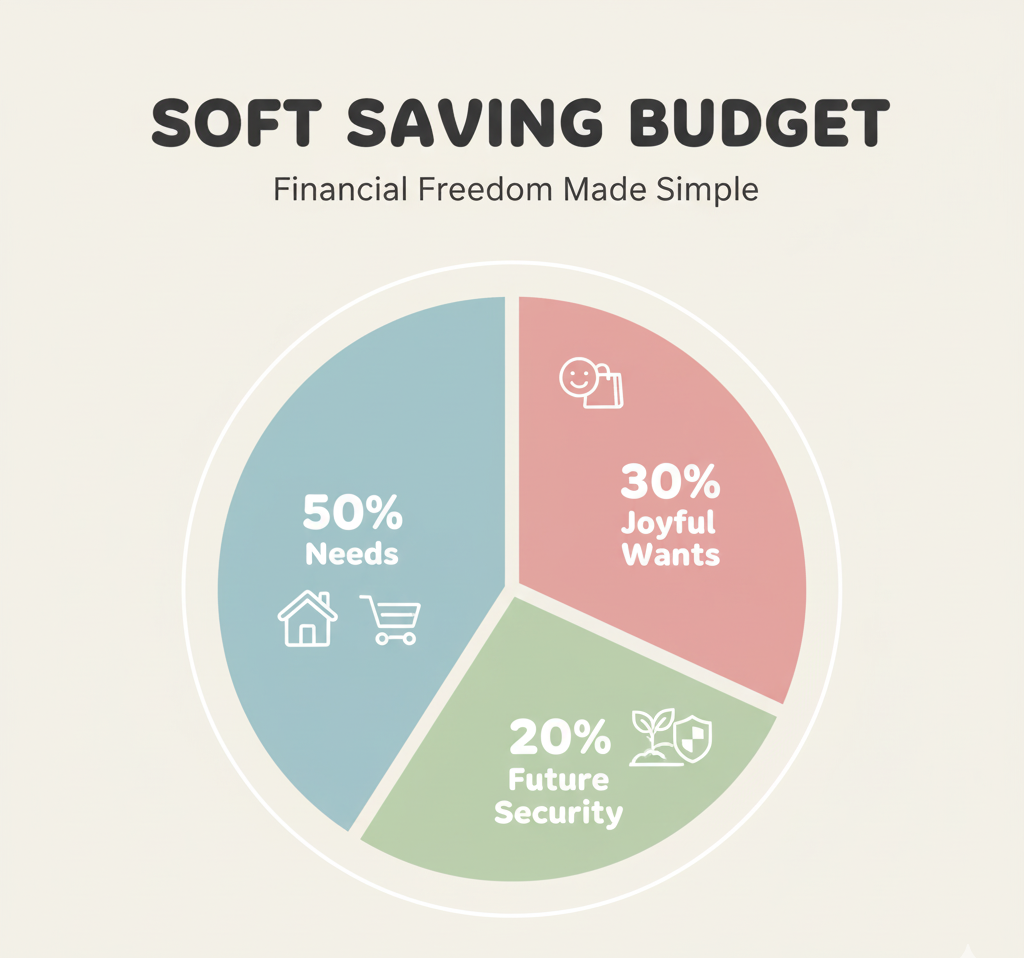I would look at my budget spreadsheet with a pang of guilt over my every coffee purchase against investment. I was achieving my saving target, but my twenties were like a marathon I was too tired to participate in. Then I found Soft Saving, and it has not only changed my pocketbook, but it has restored my life.

What is the Soft Saving Problem?
Soft Saving goes directly to the issue of financial burnout. Instead, over the years, financial advice has mostly been in your face: maximize your 401(k), side-hustle, and sacrifice enjoyment now to invest in the future. This hustle culture mindset in combination with financial stressors such as student loans and escalating prices has left many Gen Zers and Millennials anxious and deprived.

This is addressed by Soft Saving that encourages a more balanced and holistic approach. It turns the emphasis on sheer wealth collection to the financing of an enjoyable life today, and yet the future remains their responsibility. It’s not only a retirement number but rather matching your values with the money.
The Step-by-Step Guide to Soft Saving.
You do not need to become irresponsible in financial matters. This is the way to use a Soft Saving strategy in 2025.
- Audit Your Joys and Ends (The 50/30/20 Refresh): Remember the rigid ancient rules. Consider the traditional 50/30/20 budget (Needs/Wants/Savings) and make it personal.
50% of Needs: Non-negotiable items such as rent, utilities, groceries and minimum debt payments.
30% of Joyful Wants and “Present Savings”: The main part of Soft Saving. This amount is spent on hobbies, traveling, going out to eat, and most importantly, saving towards short term plans such as a course, a new laptop or a concert ticket fund.
20% Future Security: This goes to your emergency fund, retirement plans and paying down your debts beyond minimums.
- Define Your “Rich Life” ( The Values Check): Take 30 minutes and write about your definition of a rich life. Does it go to two new countries annually? The financial buffer to work part-time? These values should be directly financed out of your “Wants” budget.
- Automate Your Security (Set-and-Forget): Have your 20 percent Future Security funds transferred every time you earn a paycheck. This way your future is still being secured without having to work hard all the time to accomplish this, as to leave your mental energy to appreciate the present.
- Spend Guilt-Free (The Permission Step): This step is the most important. As soon as you have satisfied your Needs and Future Security, the amount in the “Joyful Wants” column is free for your use–without any sense of shame. That cup of coffee, that old jacket, that weekend outing, it is all included in the scheme.
Common Mistakes to Avoid
- No Saving for Soft Saving: Soft Saving is not a very good reason to be irresponsible. It is actually a deliberate redistribution, not a renouncing of saving. It is a serious mistake to overlook entirely your emergency fund or your retirement.

- Getting Lifestyle Inflation Creep In: When you get a raise, it’s tempting to pour it into your Wants, but you shouldn’t. Look at dividing the growth between your Future Security and your Joyful Wants and keep adding security.
- Do not compare your budget allocations with others and do what pleases you.
My Personal Recommendation
Once I embraced this approach, the largest shift that I made was establishing a separate Experience Fund under my Joyful Wants category. I set up an automatic deposit of a small value every week to a different online savings account. Viewing it accumulating toward a particular purpose, such as a music festival or an overnight hiking excursion, makes spending it seem like an occasion, not a financial disappointment. It has turned my money into an instrument of happiness, rather than a cause of anxiety.
QA
Q:Is Soft Saving merely a pretext to live irresponsibly?
No. It is a deliberate intentioned plan. Unfrugal action is impulsive and does not think of the future. The concept of Soft Saving focuses on providing to your future security (via automation) and then willfully uses the rest of the money to improve your current life.
Q:Will I be able to retire early using a Soft Saving strategy?
It relies upon your priorities. When your definition of a rich life is early retirement (FIRE), then your category of Joyful Wants may have an excessively heavy weighting toward investments. The framework is called Soft Saving; you put your own objectives in it. It is, to most, a more sustainable way to retire without the burnout of extreme frugality.
Q:I have a lot of debt. Can I still do this?
Yes, but your Future Security category could become momentarily a Debt Destruction category. The trick is not to give up any little, even a small, sum to your “Joyful Wants” yet. Even half of your salary on guiltless coffee or a film will help you avoid that sense of deprivation that usually results in budgetary abandonment.
Q:What is the difference between this and YOLO?
YOLO (You Only Live Once) is usually a carefree, short sighted attitude. Soft Saving is a long term strategic philosophy. It recognizes that you are living once only, and you should create a life you enjoy in this life, not in some distant retirement, and not in a frenzied spurt. It is a question of moderation, not wantonness.

Q:Is Soft Saving merely a fancy word to say bad with money?
No, it’s the opposite. Bad with money is generally unorganized and spontaneous. Soft Saving is a conscious and intentional approach. It means preparing a budget in which everything that you really need and which is a guarantee of your future will be taken care of first, and then spending the rest of your money deliberately on enhancing your present quality of life. Being in control not out of control.
Q:But how do I know whether I am soft saving or I am simply spending much?
The distinction is will and safety. You are Soft Saving if:
- Your key bills and minimum debt is covered.
- You are working towards an emergency fund and retirement.
- The money that you spend on having fun is pre-determined in your budget.
- You are spending too much when your discretionary purchases lead to you missing bill payments, accruing credit card debt, or depleting your emergency fund.
Q:I’m a very goal-oriented saver. Will this way cause me to be a sluggard?
Not necessarily. Soft Saving merely reinvents the targets. Rather than having one, distant objective such as retirement, it will help you to have serious short and medium term objectives as well. Your target may be “saving three thousand dollars to attend a coding bootcamp” or you may want to create a fund to spend on a weekend outing every quarter. This adds additional high-frequency points of success and inspiration along the way.
Q:Now, when inflation and economic uncertainty are on the rise, is it good to spend extra money on wants?
This is a valid concern. The Soft Saving model does facilitate financial strength, in fact. Through focusing on your emergency fund (a need) you are creating a buffer to uncertainty. The remaining amount of this security is called the allocated wants spending. When facing hard times, the first and simplest area to reduce expenditure is the category of wants, wherein you cannot afford to compromise your life’s safety net.
Q:The generation of my parents scrimped and saved on things. What do I say to them about this change?
Present it as an answer to a new world. You might say: The scrimp and save model was an ideal fit in a time of pensions and cheaper prices. Today, there is student debt, the gig economy and various definitions of success. My attitude makes me safe when I grow older, but I am also creating the life I do not have to get out of. I am spending my money to enjoy myself during all parts of my life, not only the final.
Q:What is a good initial percentage of the “Joyful Wants” category?
Although the updated 50/30/20 framework is an excellent reference point, begin with a self-assessment. Your Needs and Future Security (e.g., 15% to retirement, 5% to emergency fund). What remains then is your commencement of Wants. It might be 25% or 35%. The trick is to make sure that your Future Security investment is substantial and increasing, and your Wants paid with the rest, not vice versa.
Q:What about Soft Saving? Can I do it when I want to purchase a house in the future?
Absolutely. In such a situation, acquiring a house is among your top “Values.” You would just change your budget categories. A bigger part of your Future Security category would be channeled into your house down payment fund. You can temporarily decide to have a smaller “Joyful Wants” budget in order to reach your goal faster, however, the premise has not changed, you are mindfully spending money on what is most important to you.
Q:What role does investing play in the Soft Saving philosophy?
An important part of the Future Security pillar is investment. Soft Saving is not anti-investing but anti-miserable now to a hypothetical future. The plan will motivate you to automate your investments (e.g., index funds, Roth IRA) to create long-term wealth, which you can rely upon to grow consistently, so you do not always need to worry about it. This leaves you with your mind free to spend your Wants budget on the present.
Q:I am guilty of spending money on myself. How do I get over that?
This is common. Begin small and go with your budget as authorization. It is not a failure when you spend the first fifteen of the thirty dollars you set aside as fun this month on a book, but rather the plan in action. Keep a record of your happy expenditures and consider how it made you feel good. Were your relationships strengthened by that dinner with friends? Did your new hobby help you de-stress? The positive return to investment on your well-being aids the dissolution of guilt.
Q:Is this a trend limited to the youths?
Popularized by the younger generations who are forced to move through a distinct economic environment, the underlying principle transcends time. A Soft Saving strategy can help anyone who feels burned out by conventional, strictly limiting financial planning. It is about spending in accordance with your own values at any age, age 25, 45 or 65 years. The percentages in that budget can vary; however, that value-based budget philosophy is universal.

